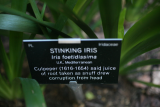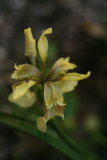Additional notes (click to expand)
Medicinal
In traditional medicine Stinking gladwin has a long history of medicinal use, though it can be rather strong in its action and so is little used nowadays[Phillips. R. & Foy. N. Herbs Pan Books Ltd. London. 1990 ]. The root is anodyne, antispasmodic and cathartic. A decoction of the roots acts as a strong purge, it has also been used as an emmenagogue and for cleaning eruptions. The powdered or infused dried root is beneficial in the treatment of fainting, nervous complaints and to relieve pains and cramps[Grieve. A Modern Herbal. Penguin 1984]. The plant has been used as a cure for ringworm[Chopra. R. N., Nayar. S. L. and Chopra. I. C. Glossary of Indian Medicinal Plants (Including the Supplement). Council of Scientific and Industrial Research, New Delhi. 1986].
https://pfaf.org https://pfaf.org/user/Plant.aspx?LatinName=Iris+foetidissima
Toxicity
Toxic internal effects. Can cause skin sensitization.
Professor Anthony Dayan, 2022
Geographical distribution
- Africa, Macaronesia, Azores
- Africa, Macaronesia, Canary Is.
- Africa, Northern Africa, Algeria
- Africa, Northern Africa, Morocco
- Europe, Northern Europe, Great Britain
- Europe, Southeastern Europe, Italy
- Europe, Southwestern Europe, France
- Europe, Southwestern Europe, Portugal
- Europe, Southwestern Europe, Spain
Iris foetidissima L.
Family: IRIDACEAEGenus: Iris
Species: foetidissima L.
Common names: Stinking Iris; Gladdon Iris; Roast-Beef Plant
Distribution summary: U.K., Mediterranean
Habit: Perennial
Hardiness: H5 - Hardy; cold winter
Habitat: Deciduous woods, scrub, hedgerows, calcareous woods
Garden status: Currently grown
Garden location: Plants of the World (B)
Reason for growing: Medicinal, toxic
.JPG)
.JPG)

.JPG)
.JPG)
.JPG)
.JPG)

